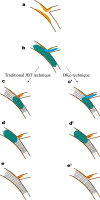Double kissing inflation outside the stent secures the patency of small side branch without rewiring
- PMID: 33962571
- PMCID: PMC8106182
- DOI: 10.1186/s12872-021-02028-z
Double kissing inflation outside the stent secures the patency of small side branch without rewiring
Abstract
Background: The jailed balloon technique is widely used for coronary bifurcation lesions, but a residual risk of SB occlusion remains, necessitating SB rewiring and further interventions, including balloon inflation or stenting, which may result in failure and SB loss. This study introduced a novel modified technique of small side branch (SB) protection, namely, double kissing inflation outside the stent (DKo) technique, for coronary bifurcations without the need for SB rewiring.
Methods: We performed the DKo technique in consecutive patients in our center from 1/2019 to 12/2019. The procedure was as follows. We inserted a guide wire into both branches followed by proper preparation. The SB balloon was simultaneously inflated with main vessel (MV) stenting. The SB balloon remained in situ until it was kissing inflated with postdilation of the bifurcation core, which is different from traditional strategies. The proximal optimization technique was performed with a short noncompliant balloon strictly not exceeding the bifurcation. Rates of SB loss and in-hospital outcomes were evaluated.
Results: The technique was successfully performed in all 117 enrolled patients without any rewiring or SB loss. The mean lesion lengths of the MV and SB were 38.3 ± 19.9 mm and 11.7 ± 7.1 mm, respectively. On average, 1.5 ± 0.6 stents were used per patient, while the mean pressure of the SB balloon was 7.4 ± 3.1 atm. DKo achieved excellent procedural success in the proximal and distal MVs: increased minimal lumen diameter (0.64 ± 0.58 mm to 3.05 ± 0.38 mm, p < 0.001; 0.57 ± 0.63 mm to 2.67 ± 0.35 mm, p < 0.001) and low residual stenosis (11.4 ± 3.4%; 7.2 ± 4.6%). DKo secured the patency of the SB without any rewiring and improved the SB stenosis with minimal lumen diameter (0.59 ± 0.48 mm to 1.20 ± 0.42 mm, p < 0.001) and stenosis (71.9 ± 19.4% to 42.2 ± 14.0%, p < 0.001). No MACE was noted in the hospital.
Conclusions: DKo for bifurcation lesions was shown to be acceptable with high procedural success and excellent SB protection.
Keywords: Coronary bifurcation lesion; Kissing balloon inflation; Percutaneous coronary intervention; Side branch protection.
Conflict of interest statement
All authors declare no competing financial interests.
Figures




Similar articles
-
Modified balloon-stent kissing technique avoid side-branch compromise for simple true bifurcation lesions.BMC Cardiovasc Disord. 2019 Apr 8;19(1):89. doi: 10.1186/s12872-019-1052-0. BMC Cardiovasc Disord. 2019. PMID: 30961533 Free PMC article.
-
Impact of kissing balloon inflation on the main vessel stent volume, area, and symmetry after side-branch dilation in patients with coronary bifurcation lesions: a serial volumetric intravascular ultrasound study.JACC Cardiovasc Interv. 2013 Sep;6(9):923-31. doi: 10.1016/j.jcin.2013.04.019. Epub 2013 Aug 14. JACC Cardiovasc Interv. 2013. PMID: 23954062
-
Szabo 2-stent technique for coronary bifurcation lesions: procedural and short-term outcomes.BMC Cardiovasc Disord. 2020 Jul 7;20(1):325. doi: 10.1186/s12872-020-01605-y. BMC Cardiovasc Disord. 2020. PMID: 32635890 Free PMC article.
-
Stent Deformation Caused by Entrapment of the Side Branch Balloon Catheter During the Jailed Balloon Protection Technique for a Calcified Coronary Bifurcation Lesion: A Case Report and Literature Review.Cardiovasc Revasc Med. 2019 Nov;20(11):1023-1026. doi: 10.1016/j.carrev.2018.11.003. Epub 2018 Nov 22. Cardiovasc Revasc Med. 2019. PMID: 30497930 Review.
-
Stenting of bifurcation lesions: a rational approach.J Interv Cardiol. 2001 Dec;14(6):573-85. doi: 10.1111/j.1540-8183.2001.tb00375.x. J Interv Cardiol. 2001. PMID: 12053378 Review.
Cited by
-
The 17th expert consensus document of the European Bifurcation Club - techniques to preserve access to the side branch during stepwise provisional stenting.EuroIntervention. 2023 May 15;19(1):26-36. doi: 10.4244/EIJ-D-23-00124. EuroIntervention. 2023. PMID: 37170568 Free PMC article.
-
Double Kissing Inflation Outside the Stent Versus Jailed Balloon Technique for Coronary Bifurcation Lesions.JACC Asia. 2023 Jun 27;3(4):678-682. doi: 10.1016/j.jacasi.2023.04.001. eCollection 2023 Aug. JACC Asia. 2023. PMID: 37614543 Free PMC article.
-
Risk factors and clinical consequences of side branch occlusion in left anterior descending bifurcation percutaneous coronary intervention: a validation study of the V-RESOLVE score.Front Cardiovasc Med. 2025 Jul 18;12:1648244. doi: 10.3389/fcvm.2025.1648244. eCollection 2025. Front Cardiovasc Med. 2025. PMID: 40756602 Free PMC article.
-
Review of Techniques for Protecting Side Branch from Occlusion during Provisional Stenting in Coronary Bifurcation Lesions.Rev Cardiovasc Med. 2023 Nov 23;24(11):323. doi: 10.31083/j.rcm2411323. eCollection 2023 Nov. Rev Cardiovasc Med. 2023. PMID: 39076435 Free PMC article. Review.
References
-
- Di Gioia G, Sonck J, Ferenc M, Chen SL, Colaiori I, Gallinoro E, et al. Clinical outcomes following coronary bifurcation PCI techniques: a systematic review and network meta-analysis comprising 5,711 patients. JACC Cardiovasc Interv. 2020;13(12):1432–1444. doi: 10.1016/j.jcin.2020.03.054. - DOI - PubMed
-
- Crimi G, Mandurino-Mirizzi A, Gritti V, Scotti V, Strozzi C, de Silvestri A, et al. Percutaneous coronary intervention techniques for bifurcation disease: network meta-analysis reveals superiority of double-kissing crush. Can J Cardiol. 2020;36(6):906–914. doi: 10.1016/j.cjca.2019.09.002. - DOI - PubMed
-
- Behan MW, Holm NR, de Belder AJ, Cockburn J, Erglis A, Curzen NP, et al. Coronary bifurcation lesions treated with simple or complex stenting: 5-year survival from patient-level pooled analysis of the Nordic Bifurcation Study and the British Bifurcation Coronary Study. Eur Heart J. 2016;37(24):1923–1928. doi: 10.1093/eurheartj/ehw170. - DOI - PubMed
Publication types
MeSH terms
LinkOut - more resources
Full Text Sources
Other Literature Sources
Medical
Research Materials
Miscellaneous

